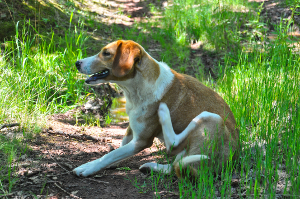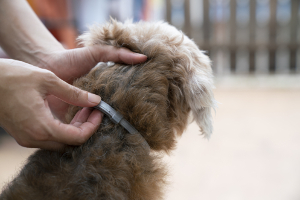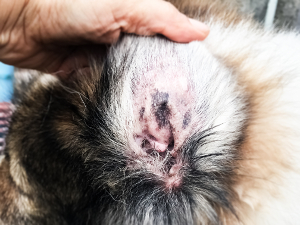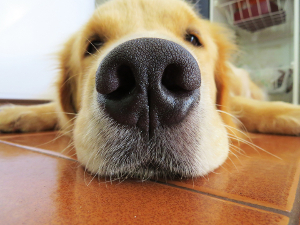Dogs can catch a variety of nasty skin conditions just like humans; however, they can sometimes be hard to spot under your dog’s fur. Some of these conditions are relatively harmless, but some can be quite serious. This article will tell you all about the most common dog skin conditions in the UK, how you can spot them, and how you can treat them!
Signs Your Dog Has a Skin Condition
While it can be tricky to spot skin problems beneath your dog’s coat, there are a few different warning signs you can look out for. You should regularly groom your dog and separate their fur with your fingers to try and pinpoint these problems. Look out for:
- Constant scratching, or excessively scratching particular areas
- Your dog seems uncomfortable when you touch particular areas of skin
- Your dog’s coat beginning to look dull or patchy
- Residues forming around their eyes and ears
- Discharge coming from their ears – in this case, take them to the vets
Causes of Dog Skin Conditions
 Usually, dry skin in dogs isn’t more than a minor inconvenience to them. It’s fairly common and usually occurs during hot, dry periods. This can be in summer if your dog spends a lot of time outside, as well as in winter when you’re more likely to have the heating on indoors. This heat can lead to a bit of dry skin and itchiness, but it’s nothing to worry about unless your dog is constantly scratching so much that the area becomes sore.
Usually, dry skin in dogs isn’t more than a minor inconvenience to them. It’s fairly common and usually occurs during hot, dry periods. This can be in summer if your dog spends a lot of time outside, as well as in winter when you’re more likely to have the heating on indoors. This heat can lead to a bit of dry skin and itchiness, but it’s nothing to worry about unless your dog is constantly scratching so much that the area becomes sore.
Usually, you can prevent dry skin with a combination of gentle dog shampoo and a healthier diet. Our Gentle Touch shampoo contains wheat proteins and added glycerine oil, which condition fur and skin to leave them soft and smooth. You can combine a regular shampoo session with a high-protein diet to help leave your dog’s skin in top condition.
Common Dog Skin Conditions
Dandruff
Dogs can get dandruff just like we can! It’s usually a result of dry skin or irritation, which can be caused by heating or by dirt and residues that get stuck to your dog’s fur. Dogs constantly shed skin and fur, but if their skin isn’t in top condition, it’ll flake off a bit more than usual. These skin flakes can be itchy and irritating to your pooch! A high-protein diet and a conditioning shampoo will keep their skin healthy, so it won’t flake off as much.
Mange
 Mange is a skin condition that’s actually caused by a variety of mites that can find a home in your dog’s fur. There are actually two different kinds of mange – sarcoptic and demodectic – although as demodectic mange is only passed between a mother and her puppies, it’s pretty rare. As they’re microscopic, you won’t be able to see the mange-causing mites themselves, but you will be able to notice the symptoms they cause.
Mange is a skin condition that’s actually caused by a variety of mites that can find a home in your dog’s fur. There are actually two different kinds of mange – sarcoptic and demodectic – although as demodectic mange is only passed between a mother and her puppies, it’s pretty rare. As they’re microscopic, you won’t be able to see the mange-causing mites themselves, but you will be able to notice the symptoms they cause.
Keep an eye out for your dog intensely scratching and biting themselves on particular areas of their body. The mites can affect any part of your dog’s body, but as they prefer bare skin, they most commonly affect the ears and belly of dogs. The skin irritation caused by mange can quickly develop into open sores and bald patches. It’s highly contagious among dogs, so it’s always a good idea to check your dog’s fur if they’ve been around other pets. Mange can even be transferred to humans, so it’s wise to get it treated by a vet as soon as you see any signs!
Fleas
 Fleas are another incredibly common skin parasite. Dogs are sensitive to fleas, and flea bites can cause severe itching. If your dog constantly itches at irritated areas, this can lead to breaks in the skin and secondary infections. Also, as you’re probably aware, fleas can hop onto humans and infest your whole home very quickly, so it’s definitely something you’ll want to avoid.
Fleas are another incredibly common skin parasite. Dogs are sensitive to fleas, and flea bites can cause severe itching. If your dog constantly itches at irritated areas, this can lead to breaks in the skin and secondary infections. Also, as you’re probably aware, fleas can hop onto humans and infest your whole home very quickly, so it’s definitely something you’ll want to avoid.
Again, you should watch for your dog itching excessively – that’s a dead giveaway for fleas. You can actually see fleas if you look hard enough, so make sure you regularly comb through your dog’s fur to check for fleas if you notice them itching a lot. Keep up with regular flea treatment and make sure they wear a flea collar if you’re worried about fleas.
Yeast Infections
 Yeast infections are common in dogs. Yeast is a fungus-like organism that is found on most dogs (and, in fact, on most living things), but if your dog’s skin is strong and healthy, these organisms won’t be able to cause any infections. However, if your dog is recovering from another infection, these organisms can quickly multiply and cause a full-blown yeast infection. Yeast can also be a problem in hot, humid conditions, even if your dog is healthy!
Yeast infections are common in dogs. Yeast is a fungus-like organism that is found on most dogs (and, in fact, on most living things), but if your dog’s skin is strong and healthy, these organisms won’t be able to cause any infections. However, if your dog is recovering from another infection, these organisms can quickly multiply and cause a full-blown yeast infection. Yeast can also be a problem in hot, humid conditions, even if your dog is healthy!
Yeast finds it easiest to multiply in shaded, warm areas. This means they’re commonly found in your dog’s ear canal (especially in long or floppy-eared dogs), between their toes, and around their rear. It causes itching, redness and swelling on the skin, and some parts of your dog’s skin might feel thick or rough. Yeast infections also give off a pungent smell that’s easy to identify. If you suspect your dog has a yeast infection, take them to the vet who’ll probably prescribe some anti-fungal treatments.
You can help prevent yeast infections by cleaning your dog’s fur regularly, taking extra care to clean between the toes and around the ears. You can use our Ear Wipes to gently clean around your dog’s ears, keeping them clean and reducing the risk of yeast infections.
Immune System Disorders
 In rare cases, skin conditions that don’t seem to heal and which don’t have any obvious cause can stem from autoimmune disorders. These disorders mean that your dog’s immune system attacks the cells in its own body, which can result in inflammation and sores. You might also notice your dog is regularly uncomfortable and unwell. Autoimmune disorders will have to be diagnosed and treated by a vet, but they are relatively rare.
In rare cases, skin conditions that don’t seem to heal and which don’t have any obvious cause can stem from autoimmune disorders. These disorders mean that your dog’s immune system attacks the cells in its own body, which can result in inflammation and sores. You might also notice your dog is regularly uncomfortable and unwell. Autoimmune disorders will have to be diagnosed and treated by a vet, but they are relatively rare.
Ensuring you keep your dog well-fed and well-groomed will greatly reduce the risk of any skin conditions occurring. Consult your vet if you’d like some more detailed information on the right food to give to your dog, and regularly groom them with Pretty Pooch’s range of sensitive grooming products to keep their skin well-conditioned and healthy!


